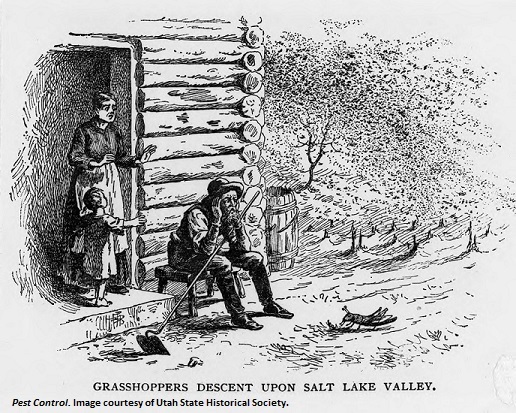Dublin Core
Title
Description
Most of us have heard the story about the 1848 Miracle of the Gulls. This week hear a new twist on that old tale – it’s the Miracle of the Crickets!
In the summer of 1848, clouds of crickets swarmed into the Salt Lake Valley and threatened to destroy Mormon crops and fields. Just as the crickets were about to devour everything in sight, seagulls miraculously appeared, eating the crickets and saving the Mormons from sure disaster. The seagull has been revered in Utah ever since. Temple Square’s Seagull Monument was dedicated in 1913 to commemorate the 1848 miracle, and in 1955 the California Gull became Utah’s state bird. But, what about the crickets?
Archaeologists have found evidence that prehistoric people living in the Great Basin ate sun-dried crickets and grasshoppers washed up on the shores of the Great Salt Lake. Similarly, Paiute, Goshute, and Shoshone people have long valued insects as a primary food source. Southern Paiutes harvested the crickets by driving them into trenches lined with dried grass and brush, and then lit the trenches on fire. In the Sevier River drainage, crickets were driven into nearby streams with willow branches, scooped up in carrying baskets, and taken home to roast. Once harvested, crickets and grasshoppers were ground into meal for cakes or mush. Western explorers called the concoction “desert fruitcake,” and some of them said the delicacy tasted quite good, like “sugar used by the white woman in her cakes.”
In contrast with their Anglo neighbors, Native Americans would have viewed the 1848 cricket invasion as a true Godsend, like manna from heaven. They had the right idea. Sun-dried grasshoppers are 60% protein, 10% carbohydrate, and have approximately 3,000 calories per kilogram. Crickets contain similar nutritional value.
So it seems the seagulls are this story’s real culprits. Crickets would have yielded far more calories than any crops the pioneers hoped to harvest. But culture dictated otherwise. Crickets and grasshoppers were not the diet of ‘civilized’ society. So maybe we really are what we eat. Roasted cricket anyone?
Creator
Source
Image: Pest Control. Rocky Mountain Crickets almost destroyed the agriculture that was planted the first summer of 1847. With a different perspective, the crickets might have been seen as a blessing. Used in the Utah Historical Quaterly Vol. 41-1 1973. Courtesy of Utah State Historical Society.
_______________
See David B. Madsen and Brigham D. Madsen, “One Man’s Meat Is Another Man’s Poison: A Revisionist View of the Seagull ‘Miracle’” in A World We Thought We Knew: Readings in Utah History edited by John S. McCormick and John R. Sillito (Salt Lake City: University of Utah Press, 1995), pp. 52-67.

